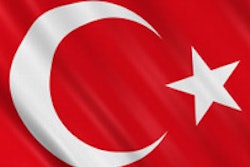
VIENNA - It may seem hard to believe, but the first reference to venous thromboembolism was made between 600 and 900 B.C. Susruta Samhita, an ancient Sanskrit text that formed the basis of traditional Indian medicine, referred to a painful swollen leg.
This was one of many fascinating facts presented by Dr. Lawrence Goodman, a radiologist from the Medical College of Wisconsin, Milwaukee, U.S., during Sunday's Wilhelm Conrad Röntgen Honorary Lecture, "In Search of Venous Thromboembolism: The First 2,912 Years," at the European Congress of Radiology (ECR).
It has taken a long time to understand venous thromboembolism -- pulmonary embolism (PE) and deep vein thrombosis (DVT) -- and this knowledge-building process has raised many questions, he explained.
 Dr. Lawrence Goodman (right), radiologist from the Medical College of Wisconsin, Milwaukee, U.S. Image provided by ESR.
Dr. Lawrence Goodman (right), radiologist from the Medical College of Wisconsin, Milwaukee, U.S. Image provided by ESR.
Describing the current situation, Goodman noted that progress has occurred in nuclear medicine, with three-tier reporting, SPECT imaging, and clot tagging. MRI will continue to get better and better, while in CT there has been a dramatic decrease in radiation, decreased noise, and increased spatial resolution. In terms of treatment, no one size fits all, he said.
Small pulmonary emboli represent a particular challenge. A CT pulmonary angiogram (CTPA) is too sensitive because it detects too many small PE. Conversely, in the mid-1990s, CTPA was too insensitive because it missed small PE.
Subsegmental PE may not need anticoagulation, particularly if there is risk of contraindication to anticoagulation, no DVT, no long-term risk factors, and good cardiopulmonary reserve. Major triggering factors include surgery, trauma, and being bedridden. Minor triggering factors are oral contraceptives, pregnancy, long flights, and immobilization, he said.
In Europe, the earliest reference to venous thromboembolism is thought be in around 1220 in France, when DVTs were described in an illustrated manuscript. In the 1500s, it is thought that Henry VIII of England suffered from a DVT due to trauma, and Mary, Queen of Scots, had a DVT during pregnancy.
In 1761, Giovanni Morgagni, the Italian anatomist and father of modern anatomical pathology, referred to large clots in the lung. Sometime between 1820 and 1840, Laennec and Cruveilhier of France described pulmonary emboli. In the 1850s, Rudolf Virchow of Germany wrote about "triad: stasis-trauma-hypercoagulability" and "embolia."
"It's very appropriate that this lecture is named in honor of Dr. Röntgen, the father of medical imaging and all of us," Goodman said.
At the end of the lecture, he also acknowledged the following article by Dr. Ken Wood as being of particular value: History of Pulmonary Embolism and Deep Venous Thrombosis, Clin Crit Care 2009;25:115. He also paid special thanks to Dr. Paul Stein, Dr. Martine Rémy-Jardin, Dr. Leonard Freeman, Dr. Scott Reeder, Dr. James Dalen, Dr. Kaushik Shahir, and Dr. W. Dennis Foley.
Originally published in ECR Today March 5, 2012.
Copyright © 2012 European Society of Radiology



















